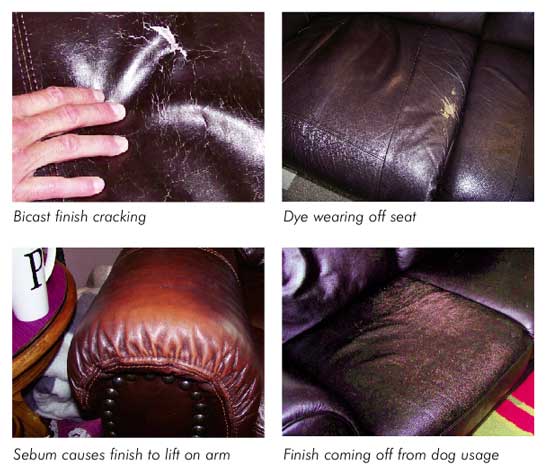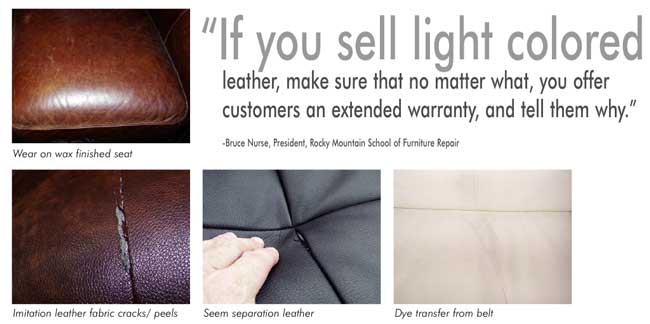This installment in Furniture World’s leather guide builds on information presented in the March April issue that detailed the different kinds of leather, plus everything retailers need to know about leather durability, quality and price.
This time our panel of industry experts follows upon it’s discussion of current leather trends with leather buying facts, advice on servicing and cleaning leather, plus warranties.
Leather Repair Tips From Bruce Nurse
The following are repair tips from Bruce Nurse, President of Rocky Mountain School of Furniture Repair where he provides hands-on workshops in professional leather repair; wood repair and refinishing; upholstery repair; hardwood floor repair and renewal. He also owns the Guardsman FurniturePro franchise in Edmonton, Alberta, Canada.
Headrest Staining: It would be beneficial for salespeople to receive education on cleaning and care of various finishes. For example, a significant issue with all finishes is sebum on the headrest and armrest. It seems to show up more on reclining pieces. This is where oils are absorbed, penetrating the leather of anilines and semi-anilines. Often times this looks dark and dirty and is practically impossible to remove and restore. In fully finished leather, sebum first removes the pigmented dye and then the oils penetrate the leather, making it difficult to restore. In the headrest this is usually caused by hair spray, oils in the hair or the oils from a bald head. Good advice to salespeople of high end reclining products is to adjust customer expectations by letting them know that leathers will develop a natural patina, as they use them.
Seam Finish Wear: Some manufacturers are having issues with finish coming off along the seams; particularly on the seats and arms. Generally, the manufacturer will repair this within the first year. However, customers are usually left alone on this one after that time frame. And stores are left to deal with it in some way.

Seam Separation: At least one person in a furniture store or warehouse should know how to do blind stitching. Seam separation is an issue that is common in stress areas, especially on attached inside back pillows and attached arm pillows. People grabbing the corners of the attached pillows to move the pieces around or even a pet constantly sitting on the top of a back can stress areas enough to cause a seam to unravel. This appears to be more common on reclining pieces. An area often affected is the chaise to the footrest caused by people pushing their foot against the footrest in order to stretch the mechanism out into a fully reclined position. When top grain leather is sewn to top grain leather, usually the worst issue is just an unravelled seam that can be stitched back up. However, when one or more of the panels are split hide leather, a bonded leather or a vinyl; often one of the panels will tear instead of the stitching unravelling. This is worse because a more expensive repair may involve a new panel, if it is available.
Refinishing Services: Sometimes a customer will return to a store to inquire about having a leather piece they purchased several years before refinished. Perhaps dye is coming off or it is fading. It’s best to suggest the customer purchase something new because the process is not only very expensive, the suppleness will be compromised giving the refinished piece a “harder” feeling, and the new finish may not last. Often times the new finish starts to crack and/or peel within a year or two.

Fix or Order Parts? Some very knowledgeable retailers don’t try to fix their more promotional products. Other stores try to fix everything. They pull out markers and use little leather repair kits. Then they get a call from an unhappy customer three months down the road. And, I tell them that if they open up a carton and see damage on certain types of items, they should just order a replacement part because it’s the best way to fix it. End of story. It’s also a good idea to select suppliers that do a good job of engineering and sending parts because it makes the repair process faster, better and less costly.
Doing Home Inspections: When it comes to leather damage, Bruce Nurse continues to advise, “If I do a home inspection, I go with the intention that I’m going to fix the problem. If I can’t, then I order a part. So, if you find that you need to order parts 90 percent of the time, it can be more efficient to ask the customer to take photos, or send out a driver or a staff member to do an inspection. A good repair person can usually tell from a photo what needs to be ordered and should be able to give a quote on the repair. Not sending a skilled technician out twice on the same repair may be cost effective for many retailers.”
Vinyl: There seems to be a trend for some manufacturers to use cheaper vinyl. It’s something that retailers should be concerned about. With good quality vinyl, if an outside corner is torn, often times staples can be pulled out, the vinyl stretched, stapled up and it looks good. But lower end vinyls may actually tear instead of stretch. Also, a little heat applied to it will burn a hole, and using an iron in order to put a grain pattern back on, can damage the surface or result in an unnatural looking grain pattern. We’re seeing this more often especially in vinyl panels used on bed rails, headboards, footboards and then sometimes on the outside arms and front rails on sofas.
Extended Warranties: We’re seeing a lot of dye transfer from dark colored clothing, denim especially, belts or even from blankets on to light colored leather. Blues, greens and blacks just transfer right over and the leather either needs to be re-dyed which can be unwise, because chances are it’s going to come off, or panels must be replaced.
So, if you sell light colored leather, make sure that no matter what, you offer customers an extended warranty, and tell them why. If you can give customers actual reasons for buying an extended warranty from the perspective of repair, it’s much more believable and effective.
Leather Care Tips
Cleaning: Part of the reason why consumers like leather is because it is easy to care for. It is not, however, indestructible. In general, the more heavily finished a leather surface is, the more resistant it is to spills and stains. Untreated leather, however, absorbs and is easily stained by oils. It can also be harmed by abrasive cleaners, powdered products and organic solvents. Soap and water is good for routine cleaning, but many commercially available leather cleaners also work. the latter often contain lubricating materials which are intended to keep leather supple. Really dirty leather may require the use of a mild detergent solution or professional cleaning, but care should be taken because some detergent solutions can contain compounds that may harm leather. Always recommend that your customers follow the manufacturer's cleaning instructions and that they test any cleaner on an inconspicuous area first. It is also a good idea to damp wipe rather than soak the leather with water.
Pets and Placement: Some pets love to chew on leather, urinate on it and scratch it. Consumers who suspect that their pets may damage their leather upholstery may want to avoid delicate leathers.
Placement out of direct sunlight, or near radiators which may dry out the leather is also recommended.
Normal Wear and Colorfastness: Customers who anticipate that their sofa will see heavy or consistent use and are worried about dirt, stains and wear, might be well advised to purchase a sofa that is darker in color and has a heavier finish coat. More heavily finished leathers will maintain their original looks longer, but tend to be stiffer and show less natural character. Since heavily pigmented finish coats are often used to cover up less desirable leather, they will also tend to be used in less expensive upholstery applications.
Although a deep gouge or scuff mark may expose the interior of the leather and reveal a contrasting color if the leather is not fully struck through, normal use will rarely if ever wear through the grain enamel of the leather. If wear or abrasion exposes a contrasting color, this is almost always due to the pigmented finish being a different color than the aniline dyed leather crust. Sometimes this is done purposely to achieve tonal effects. The most uniform color and wear will be achieved by leather which has been dyed and finished in the same shade.
You can tell if the final pigmented finish coat is a different color than the dyed leather by examining a leather sample or patch found under the seat cushion. Just compare the pigmented surface color with the color of the opposite suede side.
Some suggested methods of cleaning leather surfaces follow. Always suggest that consumers first try any cleaning method in a hidden area.
Spills: Wipe up excess liquid immediately with a clean cloth or sponge. If necessary, use clean lukewarm water and let the leather air-dry.
Spots and stains: Apply a mild, non-detergent soap solution with a clean, wet sponge. Rinse well and let air dry. Especially stubborn dirt may require a detergent solution, but care should be taken.
Butter, oil or grease: Wipe the leather with a clean, dry cloth and let the remainder of the oil dissipate into the leather. Do not apply water or try to wash a grease spot.
Professional cleaning services: There are specialized services that clean, condition, restore, repair and spot re-finish leather furniture in consumers' homes on a regular basis. They say that this kind of routine maintenance extends the useful life of leather upholstery; keeping it clean and in top condition.
Repair of holes, cuts and burns: Although it seems unlikely; holes, cuts and burns in leather surfaces, wear and fading can be repaired to like-new condition by skilled leather craftsmen.
Next issue: Part three will include advice on leather marketing and advertising, tips on best sales practices, a leather ID chart and a glossary of leather terms for retail training.
Russell Bienenstock is Editor-in-Chief of Furniture World Magazine, founded 1870. Comments can be directed to him at editor@furninfo.com.